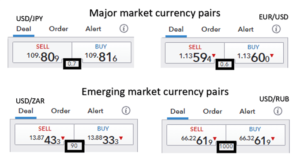by Markets Writer
This article will explore top forex spread trading techniques and key tips traders should follow to protect themselves against a widening spread.
The forex spread is the difference in price between the bid (buy) and the ask (sell) price. The spread can widen and narrow depending on a variety of reasons, which we get into shortly.
BEWARE A WIDENING SPREAD
Traders should always be aware of the spread because it is the primary cost involved in forex trading. A wider spread will lead to a larger trading cost.
Times of volatility or illiquid currency pairs accompanied with leverage could signal the end for a forex trader. Keep in mind that the more leverage used the higher the spread cost will be compared to your accounts equity, so it is beneficial to use little or no leverage.
Beginner traders should be especially wary of the spread. If you have a small account size and you take a slightly large position, relative to your account size, the spread could widen, and you may receive a margin call, or your position could even be closed.
The following three spread trading techniques and strategies are a great way to learn the basics to ensure your FX trading is a success: Keeping an eye on factors that influence the spread, the liquidity of the currency pair and the time of day.
1) KEEP AN EYE ON FACTORS WHICH AFFECT THE SIZE OF THE SPREAD
To avoid large spread costs associated with a widening spread, traders should be aware of the following factors:
- Volatility: Volatility in the market brought about by economic data releases or a breaking news event could trigger a spread to widen.
- Liquidity: A lack of liquidity in the market could also cause a spread to widen. Liquidity and volatility are two interconnected concepts. Illiquid currency pairs, such as emerging market currencies, are known for their high spreads. Illiquid markets can also be a cause of volatility.
- Spreads and the news: Before a popular news event, like the NFP employment number release, liquidity providers may widen their spreads to offset some of their risk caused by the event.
Usually the spread will revert to its mean after a few minutes, so it is advisable for traders to be patient and only trade when the spread narrows.
2) CHOOSE HIGH LIQUIDITY FOREX PAIRS
Another forex spread trading strategy many traders – particularly beginners – adopt is choosing high liquidity forex pairs. Under normal circumstances, high liquidity pairs have lower spreads.
Your major currency pairs, the EUR/USD (Euro Dollar), USD/JPY (Dollar Yen), GBP/USD (Pound Dollar), USD/CHF (Dollar Swiss Franc), will have the lowest spread amongst all currency pairs because they trade in high volumes.
These currencies do not always trade at low spreads and because they are affected by volatility, liquidity and the news which can lead to widening spreads.
Emerging market currencies like the USD/MXN (US dollar/Mexican Peso), USD/ZAR (US Dollar/South African Rand) or the USD/RUB (US Dollar/Russian Ruble), generally have higher spreads compared to your major currency pairs. Therefore, it is wise for traders to trade these pairs with less leverage, or no leverage at all.
In the image below, the black boxes show the spread of the certain currencies. The major market currency pairs, the USD/JPY and EUR/USD display narrow spreads- 0.7 pips and 0.6 pips respectively.
The emerging market currencies, the USD/ZAR and USD/RUB on the other hand, have extremely wide spreads 90 pips and 1000 pips respectively.

3) TIME OF DAY TRADING
The time of day influences forex spreads, so it can be useful factoring this in to your strategy. During your major market trading sessions – London, New York, Sydney and Tokyo – forex spreads are normally at their lowest due to the high volume being traded.
Forex traders could trade during these times to take advantage of narrower spreads. When the London and New York sessions overlap, spreads can become even narrower.
The hours shown below are Eastern Time. Between 8am and 11pm Eastern time the London and New York session overlap.

There are other factors that influence when it could be the best time of day to trade forex.
FOREX SPREAD TRADING EXAMPLE USING USD/JPY
If you combine all the above spread trading techniques, you can reduce the risk of trading at a high spread. It is important to remember these steps when executing a trade and when closing a trade because the spread may change from when you open the position to when you want to close it.
Let’s look at a simple example using the USD/JPY, which is among the major currency pairs – meaning it has high liquidity and therefore very low spreads compared to other forex pairs.
Keep an eye on factors that may affect the spread
If we were to trade the USD/JPY, we need to make sure there are no shock-events or data releases that could affect the spread. You can do this by keeping up to date with the latest news and using an economic calendar.
A sample from the economic calendar is below. Events with a ‘high impact’ have a higher chance of increasing the spread, so unless you are trading the news event, it is wise to trade around these events.
Some events that could increase volatility, and the spread include:
- GDP releases
- CPI (inflation data)
- NFP (non-farm payrolls)

Consider time of day trading
We also need to consider when to trade the USD/JPY, the USD/JPY has a lot of volatility. One of the most liquid times to trade forex in generally is between 8am and 11am eastern time, when the London and New York session overlap. The USD/JPY also is highly liquid during the Tokyo session.
Emerging market currencies can see extremely large spreads they trade out of their main market sessions. When trading emerging market currencies you should plan to trade them during their main market hours when they are most liquid.





